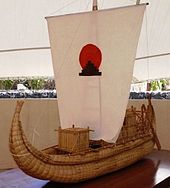Tigris[edit]
Heyerdahl built yet another reed boat, Tigris, which was intended to demonstrate that trade and migration could have linked Mesopotamia with the Indus Valley Civilization in what is now Pakistan. Tigris was built in Iraq and sailed with its international crew through the Persian Gulf to Pakistan and made its way into the Red Sea. After about five months at sea and still remaining seaworthy, the Tigris was deliberately burnt in Djibouti, on April 3, 1978, as a protest against the wars raging on every side in the Red Sea and Horn of Africa. In his Open Letter to the UN Secretary-General Kurt Waldheim, Heyerdahl explained his reasons:[32]
In the years that followed, Heyerdahl was often outspoken on issues of international peace and the environment. The Tigris was crewed by eleven men: Thor Heyerdahl (Norway), Norman Baker (USA), Carlo Mauri (Italy), Yuri Senkevich (USSR), Germán Carrasco (Mexico), Hans Petter Bohn (Norway), Rashad Nazar Salim (Iraq), Norris Brock (USA), Toru Suzuki (Japan), Detlef Zoltze (Germany), and Asbjørn Damhus (Denmark).
"The Search for Odin" in Azerbaijan and Russia[edit]
Heyerdahl made four visits to Azerbaijan in 1981,[33] 1994, 1999 and 2000.[34] Heyerdahl had long been fascinated with the rock carvings that date back to about 8th-7th millennia BCE at Gobustan (about 30 miles west of Baku). He was convinced that their artistic style closely resembles the carvings found in his native Norway. The ship designs, in particular, were regarded by Heyerdahl as similar and drawn with a simple sickle–shaped lines, representing the base of the boat, with vertical lines on deck, illustrating crew or, perhaps, raised oars.

No comments:
Post a Comment